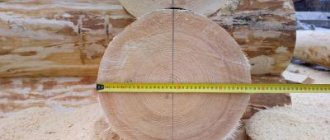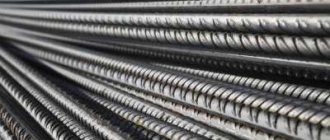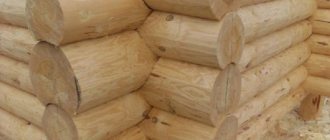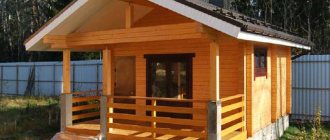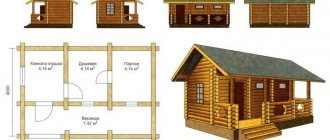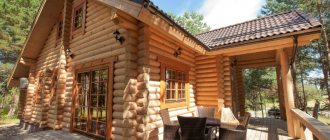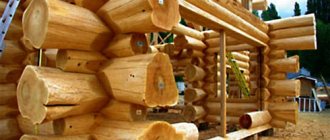Articles
All photos from the article
Building houses from wood, continuing the centuries-old traditions of our ancestors, is no longer just fashionable, but also completely justified on an environmental principle that worries more and more people every day. In addition, in terms of comfort of living, no building made from known materials can compare with a log house or a building made of timber. If you want to know what diameter of log is needed for year-round use, then check out this article.
Having chosen a certain diameter of a round timber, be prepared for the fact that the cross-section may differ on products by up to 3-4 cm
Optimal dimensions of logs
A wooden house outperforms its concrete and stone counterparts in all the most important parameters for housing:
- The ability to easily pass steam and air, which guarantees automatic adjustment of the optimal humidity level in the rooms.
- The lowest thermal conductivity, which means the house will be warm with minimal energy costs. In summer it will be pleasantly cool.
For your information! Wood fills the atmosphere of the house with a subtle, characteristic aroma that has a beneficial effect on human health. And lumber from coniferous trees has persistent antibacterial properties, purifies the air and surfaces of structures from pathogenic flora.
Protection from winds and frost for the house ensures the correct selection of lumber for the construction of a wooden frame. Today we will discuss choosing the optimal log diameter for a log house.
To the uninitiated, this question may seem far-fetched; what could be simpler, take a rounded log with a diameter of 400 or more, build it, it will be sound and warm. However, issues of energy saving and saving one’s own finances remain relevant for the vast majority of the population of our country.
In this regard, instructions for optimizing the purchase of wood for the construction of buildings for various purposes will be useful to many.
Advice! Those who intend to build with wood with their own hands should know the recommendations of professionals in this matter. And it is better to exercise control at a construction site if you know the basics of wooden construction.
Wood type
Pine is most widely used in construction due to its optimal price-quality ratio. The distinctive features of pine rounding are its beautiful structure, strength, relatively low thermal conductivity, resistance to external influences and affordable price. Arkhangelsk pine stands out because it practically does not crack.
Spruce can be considered an analogue of pine. It has fewer knots and is easier to process.
As for cedar, its spread is hampered by its high price.
The same judgment is true for larch. Which is the most suitable raw material for the production of rounded logs. Larch is resistant to temperature changes and moisture, has high density and strength. However, the cost of a rounded larch log is twice the price of a similar pine log. Such characteristics of larch logs have led to the fact that it is used as the main one when forming the lower crown of a log house.
Compliance with the region's climate
Firstly, you need to understand that two quantities play an important role in maintaining heat in a log house:
- Diameter of a rounded log.
- The width of the groove selected for assembling the structure.
The figure shows important dimensions of lumber
Important! The assembly units of a wooden frame bear the greatest heat losses (the formation of cold bridges is possible). Therefore, in addition to the ratio of the width of the groove to the thickness of the log, the tightness of the fit to the lower crown is of great importance.
The main problem of any building is heat loss during the cold months of the year.
GOST for the construction of wooden residential buildings recommends the optimal size of the groove width depending on the minimum winter temperatures characteristic of the development region:
- At an outside temperature of -20 degrees Celsius, the groove width is 130 mm or more.
- When the thermometer marks -30 (even for a short time) – the groove width is from 150 mm.
- In areas with particularly harsh winters (-40 degrees) - no less than 170 mm.
Reducing heat loss through the groove is possible by caulking these areas (in the photo, ordinary tow is replaced with jute rope)
The majority of noteworthy enterprises involved in the production of kits for construction from rounded logs have taken the groove selection rate as 0.5-0.75 times the diameter of the lumber. This means that for the regions of the first group, the optimal log frame will be about 260 mm.
Main criteria
In the field of wooden house construction, rounding is in second place after authentic manual felling. The construction of such buildings takes less time and money, since all stages of production are automated. Blanks of the same size are an ideal material for the construction of hermetic log houses.
A rounded log is easy to use, has a low price and has all the advantages of a log house. If you choose the right diameter of the building material, you can achieve high thermal efficiency.
But remember that a rounded log must be regularly treated with protective compounds, which helps combat the disadvantages of wood - rotting, cracking, and insect damage. During shrinkage, the ends are treated with water-based film-forming agents. This technology reduces internal stresses inside the tree, which are the main reason for the appearance of a large number of cracks during shrinkage.
To select the right material, the following criteria should be taken into account:
- Climate of the region.
In cold areas, thicker logs are required. - Home operating mode.
When visiting a home in the summer, the relevance of wall thickness decreases, since a reliable, but not energy-saving, building is needed. - Dimensions.
For a harmonious exterior and convenient planning, proportionality is important: a small bathhouse made of massive logs will look colorful, but the usable area will be reduced due to thick walls. Also, a large log house made from pieces of small diameter will look awkward.
Log diameters for different buildings
Secondly, you need to understand that the construction of buildings of different types will require logs of different diameters.
It all depends on:
Table of the ratio of materials compared by thermal conductivity
- Seasonality of use:
- For a winter home.
- Summer cottage or kitchen.
- Purpose of premises:
- For the bath.
- Outbuilding.
- Residential building.
- Required temperature conditions.
House
So far, everything is clear about the optimal cross-section of a log in the case of a residential building, except for those cases when neighboring log diameters are discussed, for example, 230 and 240 mm.
In principle, in both cases the following will be very close:
- Indicators of heat loss in winter.
- The ratio of the width of the inter-crown assembly groove to the diameter of the log.
And visually in a log house it will be difficult to distinguish one diameter of a rounded log from another.
Laying lumber is also very important
But the price calculated per cubic meter of wood for a 230 mm set will be significantly lower.
For clarity, we give an approximate increase in the cost of a log house of identical dimensions when switching to the closest in size (as a percentage):
- From D 200 to D 220 – 18%.
- From D 220 to D 240 – 15%.
- From D 260 to D 280 – 14%.
- From D 280 to D 300 – 14%.
- From D 300 to D 320 – 12%.
- From D 320k to D 340 – 11%.
- From D 340 to D 360 – 11%.
- From D 360 to D 380 – 10.5%.
- From D 380 to D 400 – 10.5%.
- From D 400 to D 420 – 10%.
Visual relationship between several different diameters
Note! As you can see, the difference in the cost of a set of lumber for each subsequent diameter is quite noticeable. Therefore, it is worth carefully weighing whether the price you will have to pay is balanced with the acquired benefits of greater thickness of logs.
On the other hand, a log house made from large rounded logs will be assembled from fewer crowns with the same wall height, which will result in:
- Reduces the number of butt longitudinal seams, which means it reduces heat loss through the solid surface of the walls.
- The quantity is automatically reduced:
- Corner connections.
- Wall intersection nodes.
- Reduces labor costs and the cost of installing inter-crown seams, their primary and repeated (preventive) caulking.
- Makes the exterior of a log house more impressive and solid.
To summarize, we find that lumber should be used in the construction of residential premises starting from a size of 240-260 mm or more.
For home use, which is planned only in the warm season, it is enough to take logs with a thickness of 200-220 mm. And with successful insulation, it will be quite comfortable to stay in such buildings both in autumn and spring.
For your information! The diameter of a rounded log affects not only the energy efficiency of the log house, but also its stability, strength and reliability.
Non-residential buildings
Obviously, the construction of utility and technical utility rooms will require material of a much smaller diameter:
- For a summer kitchen, lumber with a thickness of 200 mm or less is sufficient.
- Logs with a diameter below 180 mm are only suitable for non-residential buildings, such as:
- Workshops.
- Gazebos, pavilions, canopies.
- Chicken coops, barns, etc.
Which material is better to choose for a bathhouse also depends on the seasonality of use of this structure:
- Only in the summer - it is quite possible to get by with a log 180 mm thick, or even 160.
- For year-round use, you will have to spend money on lumber from 200 mm or more.
And finally, the last thing that needs to be added is that the appearance of the structure is influenced not only by the choice of the optimal diameter of the log for the log house. You should remember about the natural flow of logs during the cutting of a log house, meaning the alternation of the butt parts of the log and the tops.
It is clear that a log cannot be of the same thickness along its entire length, so the following holds:
This is a hint on how the cubic capacity of such logs is calculated
- The butt part (chopped at the root) is the thickest.
- The tip towards which the circumference of the log decreases.
The run-off of logs is especially noticeable at vertical corners, because the next log is laid with its top on the thickest part of the previous one, the next one is the opposite, etc.
Physical properties of rounded logs
- thermal conductivity. The table shows a comparison of the thermal conductivity of a log and a brick wall at different freezing temperatures.
- soundproofing . Thanks to the structure of the wood, the log does not transmit sound well, which allows you to avoid the penetration of external sounds and enjoy silence in a log house;
- strength . Caused by the presence of resin in coniferous wood and larch;
- dimensional stability . Achieved through the use of high-quality equipment. Material prepared for the website www.moydomik.net
Conclusion
Now you know how to choose the optimal diameter of a log for permanent residence, so that you feel cozy and comfortable in your home. But I would like to remind you that the building has many places that are sources of heat loss, even if you choose a log house of the required size. These elements include door and window openings, because a lot depends on the quality of the product!
In order for the house to be warm, you need to take into account a lot of specific points at the design stage: floor, walls, ceilings, basement (if any), openings
In the video presented in this article you will find additional information on this topic.
Rounded logs - GOST, regulations and standards
Please note that there is no single regulatory document regulating the production and characteristics of rounded logs. Neither in Russia, nor anywhere else at all.
Self-respecting manufacturers develop their own standards - StP (StO) - the standard of an enterprise (organization), which contains all the information about the dimensions and deviations, quality and storage conditions of the material.
However, there are a number of state standards (GOST) that regulate certain aspects of the production and storage of rounded logs:
GOST standards for rounded logs
And a number of international standards (ISO) and European standards (EN):
ISO for rounded logs
Characteristics of rounded logs according to GOST 9463-88
The most common log sizes used in practice
The rich accumulated experience in the practical construction of baths shows that most often when constructing baths, rounded logs of the following diameters are used:
- 14-16 cm. This type of lumber is rarely used for one-story bathhouse buildings, and only in warm regions of the country;
- 18-22 cm. A log structure made from logs of this diameter guarantees the strength of the building, even when adding an attic or second floor. However, its energy efficiency is not sufficient for year-round use without additional insulation;
- 24-28 cm. Logs of these diameters are used for one- and two-story bathhouse buildings, which are used in both warm and cold seasons. Additional insulation in such a situation is carried out based on the wishes of the future owner.
The most typical log diameters, most often used in domestic conditions, are considered to be three sizes - 20, 22 and 24 cm. The latter option is universal, as it is also used in the construction of permanent residential buildings that are intended for permanent residence. It should be noted that reputable manufacturers of log houses always offer the client a choice of at least 3-4 options for the size of rounded logs.
Source
Tips for purchasing and harvesting lumber
Logs must be free from insects and mechanical damage. You should choose straight trunks without curvature that have the smallest discrepancy in the diameters of the ends - up to 3 cm. For lumber longer than 3 meters, a permissible deviation of 1 cm per 1 linear meter is accepted.
Important! The complexity of the work, as well as the cost of the log house, is directly proportional to the thickness of the logs - the thicker it is, the more difficult it is to carry out construction and the more expensive it will cost.
Self-harvesting logs:
- Self-cutting of forests is carried out in winter, when the wood has a moisture content of up to 10-12% - this ensures minimal shrinkage of the building and makes it possible to use material with a smaller cross-section.
- When choosing trunks, 1 cm is added to the calculated diameter of the logs for subsequent processing.
- When using an electric or chainsaw, it must be taken into account that after using these tools, the treated surface becomes significantly tousled, as a result of which it is more susceptible to rotting. To prevent this, craftsmen recommend not to reach the marking of 5-10 mm, to cut down the wood between pre-made cross-cuts and to do the finishing hew with an axe.
- For construction, freshly cut logs are used, which are easier to process. After drying in a laid frame, such wood is less deformed and cracks.
- After removing the bark, the lumber is stacked, placing bars between the layers to organize air circulation. The logs are stored under a canopy or covered with moisture-proof material, which also protects from direct sunlight. Drying lasts two weeks, after which the felling of the log house begins. Overdried wood is difficult to process.
- To reduce cracking of logs on the facades, notches are made in each of them on the side opposite to the longitudinal groove. Their depth should be up to ¼ of the diameter of the lumber. These cuts are designed to compensate for internal stresses arising during the processes of wetting and drying under the influence of atmospheric factors, and, as a result, to prevent the occurrence of cracks.
Proper selection and harvesting of timber for construction allows you to obtain a durable, warm and aesthetically attractive bathhouse.
Source
